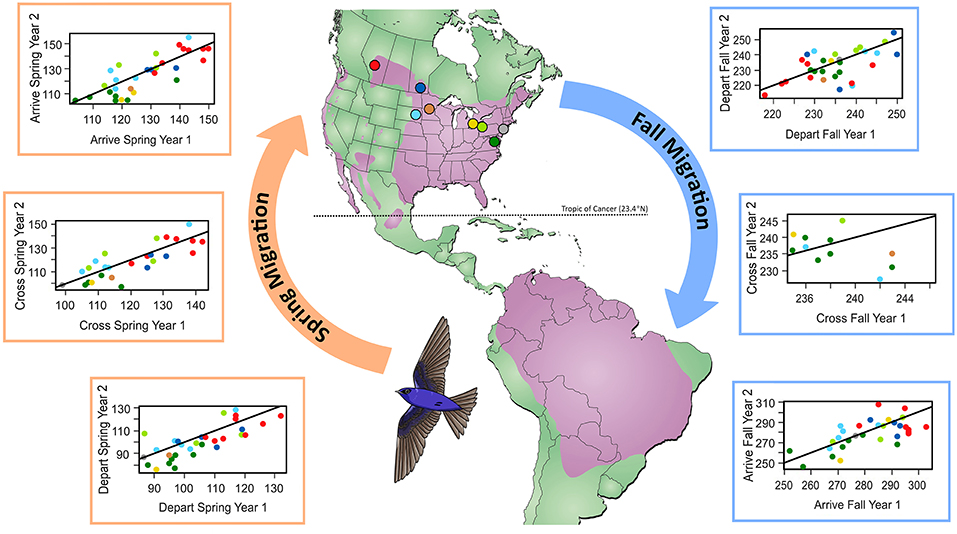
To learn more about migratory birds, visit. I can’t wait to see what we learn this year! Be sure to watch the Disney’s Animals, Science and Environment Facebook page for updates throughout the purple martin nesting season. And I mean they race! We found one of our birds flying back at 45 miles an hour. As soon as it starts to get bright outside, these birds race back to their nests to feed their young. We believe these are popular spots because they attract nocturnal insects, which are easy early-morning meals. Spring migration is somewhat staggered, with arrivals in southern areas such as Floridaand Texasin January, but showing up in the northern United States in April and in Canadaas late as May. Instead, they spend some nights on freeway light fixtures. Migrationedit Wintering in Brazil, Bolivia and parts of Peru,3purple martins migrate to North America in the spring to breed. Using the same GPS technology, we found that our birds do not always sleep in their bird houses with their chicks. Here at Walt Disney World Resort, we have been just as curious about where our nesting birds spend the night. This new information is critically important because only about 17 percent of the roosts identified were in protected areas of Brazil. Based on past observations by Brazilian scientists, we knew that many purple martins come together at night in cities and towns in the Amazon basin, but we were surprised to learn they more often frequented small islands in the Amazon River and its tributaries. Kevin Fraser of the University of Manitoba that used GPS technology to pinpoint where purple martins in Brazil go to settle at night. For example, our conservation team collaborated on a study with Dr. The researchers recently discovered that purple martins are roosting in small forest patches as they migrate from North America to Brazil. Over the past few years, we’ve learned a lot by studying the birds. They prefer birdhouses almost exclusively, which enables us to attract them to areas close enough for us to observe them as they find mates, as they find mates, lay eggs and care for their chicks until they learn to fly. All this preparation is important because purple martins have specific needs for nesting. Each house has multiple rooms, so we now have 460 nest compartments ready and waiting for purple martins to check in. To prepare for the birds’ arrival, Disney VoluntEARS gear up a month in advance by cleaning and prepping all 20 purple martin bird houses across Walt Disney World Resort. Hundreds more will soon flock here, and as they continue to arrive, we look forward to learning more about these gorgeous migratory birds.Įach year, purple martins travel to Walt Disney World Resort to raise their young before flying more than 6,000 miles to the Brazilian rainforest and back, providing us with a unique front-row seat to the magic of nature. We’re thrilled to report we’ve had one of the first 2018 purple martin sightings in the United States. Nest may have raised dirt rim in front to help keep eggs from rolling out.The beginning of a new year signals celebration and we’re off to a flying start at Walt Disney World Resort. Nest (built by both sexes) is cup of leaves, grass, twigs, debris, and usually mud. The PMCA also collects data on the location of Purple Martin colonies. This map shows the arrival dates and breeding ranges of Purple Martins. Each year (since 1998) the PMCA collects more and more data. Sometimes nests in holes in buildings or cliffs. They collect migration reports from all over the United States and then map them according to when and where they arrive. In the east, most martins now use nest boxes.

Nest: Natural sites are in cavities, mostly old woodpecker holes, in trees (or in giant cactus in southwest). Male will sometimes have more than one mate. Western martins may nest in looser colonies or as isolated pairs. Usually nests in colonies, especially in east, where almost all are in multiple-roomed nest boxes put up for them. Males return to nesting areas first in spring, establish nesting territories. The old claim of martins eating "2,000 mosquitoes a day" apparently has no basis in fact. Dragonflies may be an important part of diet. Feeds on a wide variety of flying insects, including many wasps and winged ants, and some bees also many true bugs, flies (including house flies and crane flies), beetles, moths, and butterflies.


 0 kommentar(er)
0 kommentar(er)
